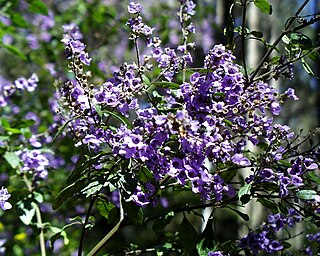
Prostanthera melissifolia, commonly known as balm mint bush, is a species of flowering plant in the family Lamiaceae and is endemic to south-eastern Australia. It is an erect shrub with hairy branches, egg-shaped leaves with fine teeth on the edges and mauve to purple or pink flowers on the ends of branchlets.

Prostanthera cryptandroides is a species of flowering plant in the family Lamiaceae and is endemic to eastern Australia. It is a low, spreading shrub with narrow egg-shaped leaves and lilac to mauve flowers arranged singly in leaf axils.

Prostanthera stenophylla is a species of flowering plant in the family Lamiaceae and is endemic to Wollemi National Park in New South Wales. It is an erect, slender, aromatic shrub with hairy, oblong leaves and small groups of pale bluish mauve to violet flowers.

Prostanthera striatiflora, commonly known as jockey's cap, striated mintbush or striped mintbush, is a species of flowering plant that is endemic to the more arid areas of Australia. It is an erect, aromatic shrub with narrow egg-shaped to narrow elliptic leaves and white flowers with purple lines inside the petal tube.

Pimelea serpyllifolia, commonly known as thyme riceflower, is a species of flowering plant in the family Thymelaeaceae and is endemic to southern Australia. It is an erect shrub with narrowly elliptic to spatula-shaped leaves, and compact heads of 4 to 12 yellow, yellowish-green or white flowers surrounded by 2 or 4 leaf-like involucral bracts. Male and female flowers are borne on separate plants.
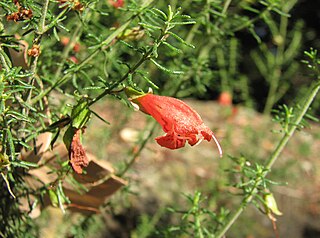
Prostanthera aspalathoides, commonly known as scarlet mint-bush, is a species of flowering plant that is endemic to south-eastern Australia. It is a small shrub with hairy branches, cylindrical or linear to elliptic or oblong leaves and red, pinkish red, or orange flowers arranged singly in leaf axils.

Prostanthera walteri, commonly known as blotchy mint-bush, is a species of flowering plant that is endemic to south-eastern Australia. It is a sprawling shrub with tangled, hairy branches, egg-shaped leaves and usually bluish green flowers with prominent purple veins arranged singly in leaf axils.

Prostanthera porcata is a species of flowering plant in the family Lamiaceae and is endemic to the Budawang Range in south-eastern New South Wales. It is a small, erect shrub with glabrous branches, elliptic leaves and deep pink or pink and cream-coloured flowers.
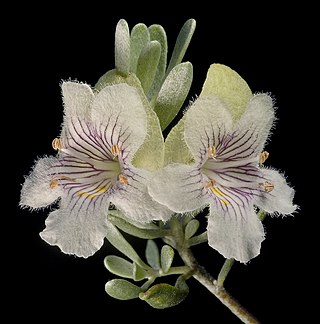
Prostanthera althoferi is a species of flowering plant in the family Lamiaceae and is endemic to inland areas of Australia. It is an erect shrub with its stems and leaves densely covered with silvery, greyish-green hairs, and has narrow egg-shaped leaves and white to cream-coloured flowers with mauve or purple striations inside.
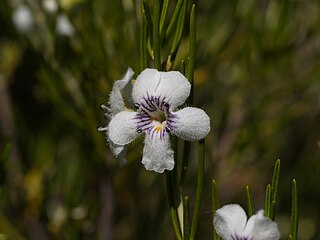
Prostanthera campbellii is a species of flowering plant in the family Lamiaceae and is endemic to the south-west of Western Australia. It is an erect shrub with linear leaves and white to cream-coloured flowers with purple striations.

Prostanthera canaliculata is a species of flowering plant in the family Lamiaceae and is endemic to the south-west of Western Australia. It is a small, erect shrub with hairy branchlets, narrow egg-shaped to narrow elliptical leaves and pale blue or pale violet to white flowers with no markings.
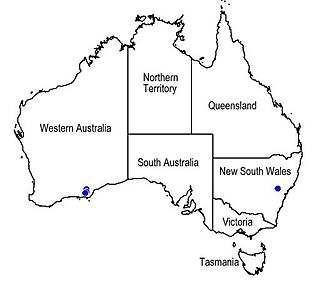
Prostanthera carrickiana, commonly known as Carrick's mintbush, is a species of flowering plant in the family Lamiaceae and is endemic to a restricted area in the south-west of Western Australia. It is an erect shrub with hairy branchlets, elliptical leaves pinkish-red flowers.

Prostanthera chlorantha, commonly known as green mintbush, is a species of flowering plant in the family Lamiaceae and is endemic to the south-east of South Australia. It is a small shrub with small, broadly egg-shaped to round leaves and mauve, bluish green, or greenish red to greenish yellow flowers with a pink tinge.
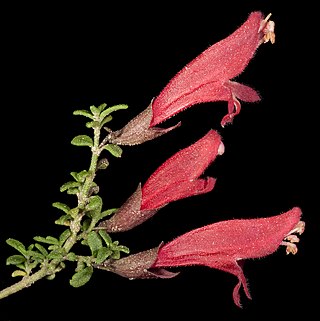
Prostanthera grylloana is a species of flowering plant in the family Lamiaceae and is endemic to Western Australia. It is a small, erect shrub with densely hairy branchlets, small, spatula-shaped leaves and red to pink flowers.

Prostanthera nanophylla is a species of flowering plant in the family Lamiaceae and is endemic to Western Australia. It is a small shrub with hairy branches, egg-shaped to elliptic or narrow oblong leaves and mauve or blue to white flowers with dull brown, maroon or purple spots.
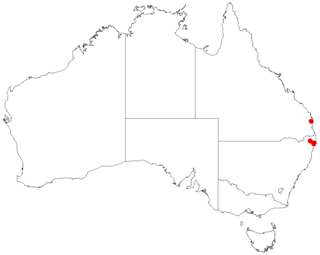
Prostanthera palustris, commonly known as swamp mint-bush, is a species of flowering plant in the family Lamiaceae and is endemic to a restricted area of New South Wales. It is a low, spreading, weak shrub with spatula-shaped leaves and pale mauve and white flowers with yellow spots in the petal tube.

Prostanthera patens is a species of flowering plant in the family Lamiaceae and is endemic to Western Australia. It is a small shrub with stiff, spine-like, hairy branches, egg-shaped to broadly elliptic, hairy leaves and red and orange to pale red flowers.
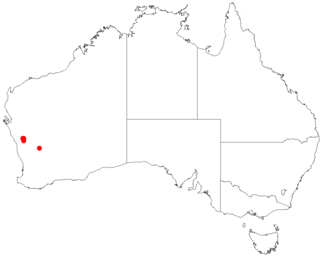
Prostanthera pedicellata is a species of flowering plant in the family Lamiaceae and is endemic to a restricted area of Western Australia. It is a small shrub with densely glandular branches, egg-shaped to oval leaves and red flowers.

Prostanthera scutata is a species of flowering plant in the family Lamiaceae and is endemic to Western Australia. It is a small, erect, compact shrub with densely hairy branches, elliptic to narrow elliptic leaves and pale blue or faintly violet flowers.

Prostanthera semiteres is a species of flowering plant in the family Lamiaceae and is endemic to Western Australia. It is a small shrub with narrow egg-shaped leaves with the narrower end towards the base and pink or red flowers.





















